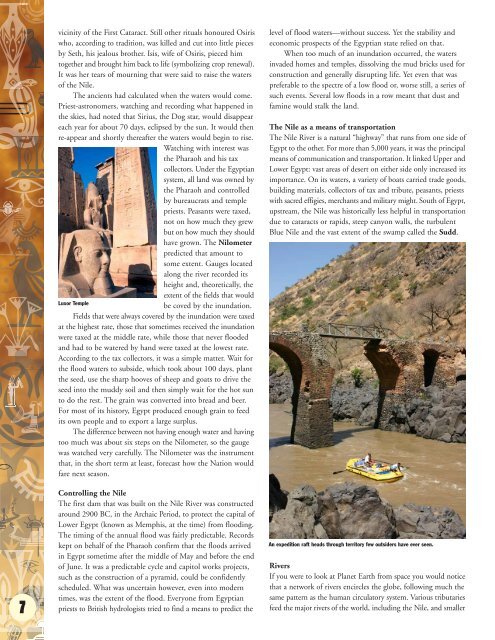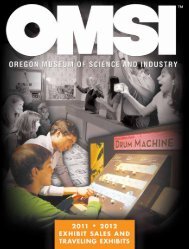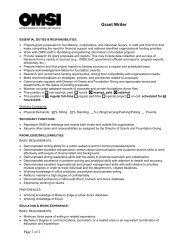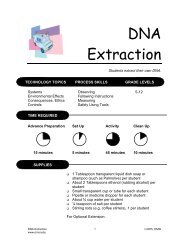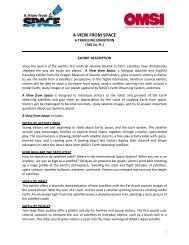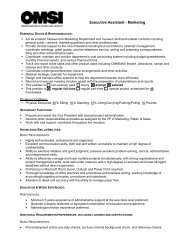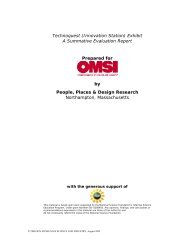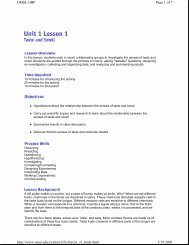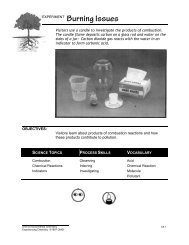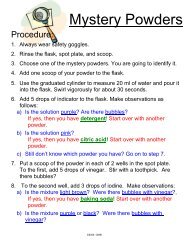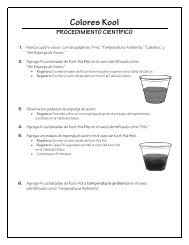Create successful ePaper yourself
Turn your PDF publications into a flip-book with our unique Google optimized e-Paper software.
7<br />
vicinity <strong>of</strong> <strong>the</strong> First Cataract. Still o<strong>the</strong>r rituals honoured Osiris<br />
who, according to tradition, was killed and cut into little pieces<br />
by Seth, his jealous bro<strong>the</strong>r. Isis, wife <strong>of</strong> Osiris, pieced him<br />
toge<strong>the</strong>r and brought him back to life (symbolizing crop renewal).<br />
It was her tears <strong>of</strong> mourning that were said to raise <strong>the</strong> waters<br />
<strong>of</strong> <strong>the</strong> <strong>Nile</strong>.<br />
The ancients had calculated when <strong>the</strong> waters would come.<br />
Priest-astronomers, watching and recording what happened in<br />
<strong>the</strong> skies, had noted that Sirius, <strong>the</strong> Dog star, would disappear<br />
each year for about 70 days, eclipsed by <strong>the</strong> sun. It would <strong>the</strong>n<br />
re-appear and shortly <strong>the</strong>reafter <strong>the</strong> waters would begin to rise.<br />
Watching with interest was<br />
<strong>the</strong> Pharaoh and his tax<br />
collectors. Under <strong>the</strong> Egyptian<br />
system, all land was owned by<br />
<strong>the</strong> Pharaoh and controlled<br />
by bureaucrats and temple<br />
priests. Peasants were taxed,<br />
not on how much <strong>the</strong>y grew<br />
but on how much <strong>the</strong>y should<br />
have grown. The Nilometer<br />
predicted that amount to<br />
some extent. Gauges located<br />
along <strong>the</strong> river recorded its<br />
height and, <strong>the</strong>oretically, <strong>the</strong><br />
extent <strong>of</strong> <strong>the</strong> fields that would<br />
Luxor Temple<br />
be coved by <strong>the</strong> inundation.<br />
Fields that were always covered by <strong>the</strong> inundation were taxed<br />
at <strong>the</strong> highest rate, those that sometimes received <strong>the</strong> inundation<br />
were taxed at <strong>the</strong> middle rate, while those that never flooded<br />
and had to be watered by hand were taxed at <strong>the</strong> lowest rate.<br />
According to <strong>the</strong> tax collectors, it was a simple matter. Wait for<br />
<strong>the</strong> flood waters to subside, which took about 100 days, plant<br />
<strong>the</strong> seed, use <strong>the</strong> sharp hooves <strong>of</strong> sheep and goats to drive <strong>the</strong><br />
seed into <strong>the</strong> muddy soil and <strong>the</strong>n simply wait for <strong>the</strong> hot sun<br />
to do <strong>the</strong> rest. The grain was converted into bread and beer.<br />
For most <strong>of</strong> its history, Egypt produced enough grain to feed<br />
its own people and to export a large surplus.<br />
The difference between not having enough water and having<br />
too much was about six steps on <strong>the</strong> Nilometer, so <strong>the</strong> gauge<br />
was watched very carefully. The Nilometer was <strong>the</strong> instrument<br />
that, in <strong>the</strong> short term at least, forecast how <strong>the</strong> Nation would<br />
fare next season.<br />
Controlling <strong>the</strong> <strong>Nile</strong><br />
The first dam that was built on <strong>the</strong> <strong>Nile</strong> River was constructed<br />
around 2900 BC, in <strong>the</strong> Archaic Period, to protect <strong>the</strong> capital <strong>of</strong><br />
Lower Egypt (known as Memphis, at <strong>the</strong> time) from flooding.<br />
The timing <strong>of</strong> <strong>the</strong> annual flood was fairly predictable. Records<br />
kept on behalf <strong>of</strong> <strong>the</strong> Pharaoh confirm that <strong>the</strong> floods arrived<br />
in Egypt sometime after <strong>the</strong> middle <strong>of</strong> May and before <strong>the</strong> end<br />
<strong>of</strong> June. It was a predictable cycle and capitol works projects,<br />
such as <strong>the</strong> construction <strong>of</strong> a pyramid, could be confidently<br />
scheduled. What was uncertain however, even into modern<br />
times, was <strong>the</strong> extent <strong>of</strong> <strong>the</strong> flood. Everyone from Egyptian<br />
priests to British hydrologists tried to find a means to predict <strong>the</strong><br />
level <strong>of</strong> flood waters—without success. Yet <strong>the</strong> stability and<br />
economic prospects <strong>of</strong> <strong>the</strong> Egyptian state relied on that.<br />
When too much <strong>of</strong> an inundation occurred, <strong>the</strong> waters<br />
invaded homes and temples, dissolving <strong>the</strong> mud bricks used for<br />
construction and generally disrupting life. Yet even that was<br />
preferable to <strong>the</strong> spectre <strong>of</strong> a low flood or, worse still, a series <strong>of</strong><br />
such events. Several low floods in a row meant that dust and<br />
famine would stalk <strong>the</strong> land.<br />
The <strong>Nile</strong> as a means <strong>of</strong> transportation<br />
The <strong>Nile</strong> River is a natural “highway” that runs from one side <strong>of</strong><br />
Egypt to <strong>the</strong> o<strong>the</strong>r. For more than 5,000 years, it was <strong>the</strong> principal<br />
means <strong>of</strong> communication and transportation. It linked Upper and<br />
Lower Egypt: vast areas <strong>of</strong> desert on ei<strong>the</strong>r side only increased its<br />
importance. On its waters, a variety <strong>of</strong> boats carried trade goods,<br />
building materials, collectors <strong>of</strong> tax and tribute, peasants, priests<br />
with sacred effigies, merchants and military might. South <strong>of</strong> Egypt,<br />
upstream, <strong>the</strong> <strong>Nile</strong> was historically less helpful in transportation<br />
due to cataracts or rapids, steep canyon walls, <strong>the</strong> turbulent<br />
Blue <strong>Nile</strong> and <strong>the</strong> vast extent <strong>of</strong> <strong>the</strong> swamp called <strong>the</strong> Sudd.<br />
An expedition raft heads through territory few outsiders have ever seen.<br />
Rivers<br />
If you were to look at Planet Earth from space you would notice<br />
that a network <strong>of</strong> rivers encircles <strong>the</strong> globe, following much <strong>the</strong><br />
same pattern as <strong>the</strong> human circulatory system. Various tributaries<br />
feed <strong>the</strong> major rivers <strong>of</strong> <strong>the</strong> world, including <strong>the</strong> <strong>Nile</strong>, and smaller


